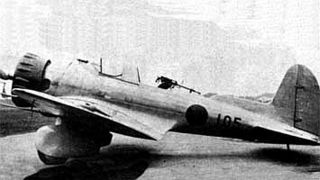Related Research Articles

The Mitsubishi A5M, formal Japanese Navy designation Mitsubishi Navy Type 96 Carrier-based Fighter (九六式艦上戦闘機), experimental Navy designation Mitsubishi Navy Experimental 9-Shi Carrier Fighter, company designation Mitsubishi Ka-14, was a Japanese carrier-based fighter aircraft. It was the world's first low-wing monoplane shipboard fighter to enter service and the predecessor to the famous Mitsubishi A6M "Zero". The Allied reporting name was Claude.

The Nakajima A1N, or Navy Type 3 Carrier Fighter, was a Japanese carrier-based fighter of the late-1920s and early-1930s. It was a licensed copy of the British Gloster Gambet fighter, built by the Nakajima Aircraft Company for the Imperial Japanese Navy. Approximately 150 were built in two versions, the A1N1 and A1N2.

The Yokosuka B4Y,, carrier torpedo bomber was used by the Imperial Japanese Navy Air Service from 1936 to 1943. The B4Y replaced the Mitsubishi B2M2 and was the last biplane bomber used operationally by the Imperial Japanese Navy. The Allied reporting name was "Jean".

The Nakajima E4N was a Japanese shipboard reconnaissance aircraft of the 1930s. It was a two-seat, single-engine, equal-span biplane seaplane used primarily by the Imperial Japanese Navy.

The Nakajima A2N or Navy Type 90 Carrier Fighter was a Japanese carrier-borne fighter of the 1930s. It was a single-engined biplane of mixed construction, with a fixed tailwheel undercarriage.

The Nakajima Ki-8 was an unsuccessful attempt by the Nakajima Aircraft Company to interest the Imperial Japanese Army Air Force in a two-seat modern monoplane fighter.

The Mitsubishi K3M was a trainer built by Mitsubishi which was used by the Imperial Japanese Navy in an extremely wide variety of roles, including light transport, liaison aircraft, utility aircraft and occasionally light bomber. Its Allied reporting name was Pine.

The Mitsubishi Ki-18 was an unsuccessful and unsolicited attempt by Mitsubishi to meet a 1934 requirement issued by the Japanese Army for a modern single-seat monoplane fighter suitable to the needs of the Imperial Japanese Army Air Force. During this competition, Nakajima entered the Nakajima Ki-11, and Kawasaki entered the more maneuverable Kawasaki Ki-10 biplane. The competition was won by Kawasaki, but the new fighter was not accepted by the IJAAF with much enthusiasm.

The Mitsubishi Army Type 92 Reconnaissance Aircraft (九二式偵察機) was a Japanese short-range reconnaissance aircraft of the 1930s designed by Mitsubishi for the Imperial Japanese Army Air Force. A total of 230 were built, serving between 1933 and 1936. A parasol monoplane, the Type 92 was the first military aircraft powered by an engine both designed and manufactured in Japan to enter service.
The Nakajima C3N-1 was a prototype Japanese carrier-based reconnaissance aircraft of the 1930s. A single-engine monoplane with a fixed undercarriage, although only two examples were built, they were both used operationally, carrying out land-based reconnaissance missions during the Second Sino-Japanese War.
The Nakajima B3N was a prototype Japanese carrier-based torpedo-bomber aircraft of the 1930s. A single-engined biplane with a crew of three, it was unsuccessful, only two being built.
The Aichi F1A was a prototype Japanese floatplane of the 1930s. A single-engined biplane, the F1A was intended as a short-range observation aircraft suitable for operation off the Imperial Japanese navy's warships, but only two were built, the Mitsubishi F1M being selected instead.

The Aichi E8A was a prototype Japanese reconnaissance floatplane of the 1930s. It was a two-seat single engined biplane built for the Imperial Japanese Navy. Only two were built.
The Kawanishi K-11 was a 1920s Japanese single-seat carrier fighter designed and built by the Kawanishi Aircraft Company to meet an Imperial Japanese Navy requirement. The type did not enter service and only two prototypes were built.

The Mitsubishi 1MF9 or Mitsubishi Experimental Taka-type Carrier Fighter was a prototype Japanese fighter aircraft of the 1920s. It was a single-engined, single-seat biplane intended to operate from the Imperial Japanese Navy's aircraft carriers, but only two were built, with the type being rejected by the Navy.
The Kawanishi E10K, also known as Kawanishi Type T, Kawanishi Navy Type 94 Transport Seaplane and Kawanishi Navy Experimental 9-Shi Night Reconnaissance Seaplane, was a small Japanese flying boat of the 1930s. It was a single-engined biplane intended to meet a requirement for a night reconnaissance aircraft for the Imperial Japanese Navy, but was not selected for production, the single prototype being converted to a transport and operated as the Navy Type 94 Transport.

The Mitsubishi 2MB2 or Experimental Washi-type Light Bomber was a prototype Japanese single-engined biplane light bomber of the 1920s. A single example was built for the Imperial Japanese Army, but no production followed.

The Mitsubishi 1MF10 or Mitsubishi Experimental 7-Shi Carrier Fighter (七試艦上戦闘機) was a prototype Japanese monoplane single-seat carrier-based fighter aircraft of the 1930s. Two were built for the Imperial Japanese Navy, but both were lost in crashes, with no production following.
The Nakajima D3N was a Japanese carrier-based dive bomber of the 1930s. Three prototypes were built for the Imperial Japanese Navy, but no production followed, with the Aichi D3A being selected instead.

The Mitsubishi Ka-12 or B4M was a Japanese carrier-based torpedo bomber of 1934. Two prototypes were built by Mitsubishi for the Imperial Japanese Navy. A development of the company's 3MT10 of 1932, the design differed primarily in the use of a radial engine and metal wing, which made the whole aircraft significantly lighter and faster. However, the design could not realise its potential as the wing was inefficiently stiff and the B4M was not selected for production. The competing Yokosuka B4Y was chosen to serve on the Navy's aircraft carriers instead.
References
- Green, William; Swanborough, Gordon (1994). The Complete Book of Fighters. New York: Smithmark. ISBN 0-8317-3939-8.
- Mikesh, Robert C.; Abe, Shorzoe (1990). Japanese Aircraft 1910–1941. London: Putnam Aeronautical Books. ISBN 0-85177-840-2.